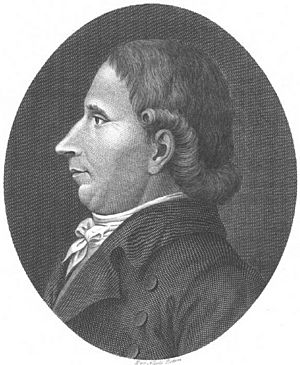Barnaba Oriani facts for kids
Quick facts for kids
Barnaba Oriani
|
|
|---|---|
 |
|
| Born | 17 July 1752 Garegnano, Milan, Duchy of Milan
|
| Died | 12 November 1832 (aged 80) Milan, Kingdom of Lombardy–Venetia
|
| Nationality | Italian |
| Occupation |
|
| Known for | detailed research of the planet Uranus |
| Parent(s) | Giorgio Oriani and Margherita Oriani (née Galli) |
| Scientific career | |
| Fields | astronomy |
| Institutions | Brera Astronomical Observatory |
Barnaba Oriani (born July 17, 1752 – died November 12, 1832) was an important Italian scientist. He was a Catholic priest, but he was also very good at studying the Earth's shape (a geodesist) and, most famously, a brilliant astronomer. He is especially known for his detailed work on the planet Uranus.
Contents
Life of Barnaba Oriani
Oriani was born in a place called Garegnano, which is now part of the city of Milan in Italy. His father was a builder who worked with stone. Barnaba later passed away in Milan.
Early Education and Priesthood
After his first schooling in Garegnano, he went to a special college in Milan called San Alessandro. He was helped and supported by a religious group called the Barnabites. He later joined this group.
He studied many subjects, including humanities, physical sciences, mathematics, philosophy, and theology. In 1775, he became a priest.
Working with Governments
When Napoleon I created the Republic of Lombardy, Oriani did not want to promise loyalty against the old monarchy. The new government changed the oath for him so he could still keep his job. He remained at the observatory.
He was also chosen to lead a group that set up a new system for weights and measures. This was a big change for the country.
Later, when the republic became a kingdom under Napoleon, Oriani received special honors. He was given the Iron Crown of Lombardy and the Legion of Honour. He was also made a count and a senator. He was asked to help measure a long distance on Earth, called an arc of the meridian, between the cities of Rimini and Rome.
Friendship with Giuseppe Piazzi
Oriani was a close friend of another important scientist, Giuseppe Piazzi. Piazzi was a monk and the person who discovered the dwarf planet Ceres. Oriani and Piazzi worked together for 37 years. They cooperated on many astronomical observations.
Oriani's Work in Astronomy
Because he was so interested in astronomy, Oriani joined the staff of the Brera Observatory in Milan in 1776. He became an assistant astronomer in 1778 and the director in 1802.
Publishing Astronomical Findings
In 1778, he started publishing detailed papers about objects in space. These were called the Effemeridi di Milano, which means the Ephemerides of Milan. An ephemeris is a table that shows where planets and stars will be at different times.
Oriani was a very skilled astronomer, and his work started to get a lot of attention. His studies on how light from stars bends when it enters Earth's atmosphere (called astronomic refraction) were very important. He also studied the tilt of Earth's axis (the obliquity of the ecliptic) and how planets move in their orbits.
Research on Uranus
His greatest achievement was his detailed research on the planet Uranus. Uranus was discovered by Sir William Herschel in 1781. Oriani spent a lot of time observing Uranus. He calculated how it moved around the Sun and published these calculations in a booklet in 1793.
After other scientists showed that Uranus was not moving in a straight line but in a nearly circular path, Oriani calculated its orbit in 1783. In 1789, he made his calculations even better. He did this by considering the pulling forces (gravity) of the giant planets Jupiter and Saturn on Uranus.
Other Publications and Honors
Besides his regular contributions to the Effemeridi, he also published a series of papers on spherical trigonometry. These were in the Memorie dell' Istituto Italiano from 1806 to 1810. He also wrote Istruzione suelle misure e sui pesi in 1831, which was about measurements and weights.
For all his important work in astronomy, an asteroid was named after him. This asteroid is called 4540 "Oriani". It was discovered at the Osservatorio San Vittore in Bologna, Italy, on November 6, 1988.
Oriani's Theorem
In one of his important works, De refractionibus astronomicis, Oriani showed how to calculate astronomical refraction. This is how much light from a star bends as it passes through Earth's atmosphere. This bending makes stars appear in a slightly different position than they actually are.
Oriani's method was special because it did not need to know the exact temperature or air density at different heights in the atmosphere. It only needed to know the temperature and pressure where the observer was standing. This made it much easier and more accurate for astronomers to correct their observations of stars.
This theorem helps explain why older, simpler models for atmospheric refraction worked well for stars that were high in the sky. It showed that for stars up to 70 degrees from directly overhead, the bending of light does not depend on the small details of how air is spread out in the atmosphere.
See also
- List of Roman Catholic scientist-clerics

